Robert and Mum Alice Visit Oman, 13 February - 7 March 2006
Robert Tyabji
Oman: a name that evokes images of royal courts and of intrepid mariners in huge latteen-sailed dhows carrying gold, silver, ivory, pearls, spices, dates, timber, exotic aromatics, and silks, navigating the Indian Ocean trade routes between ports along the Arabian peninsula and India, the Maldives, Zanzibar and the Zanj coast, and as far as Indonesia and China.
I have always wanted to experience this wondrous land of rolling sand dunes, towering mountains and palm-shaded wadis watered and cooled by ancient irrigation channels and viaducts, but somehow I wasn’t able to make it during the 5 years we lived next door, in Yemen.
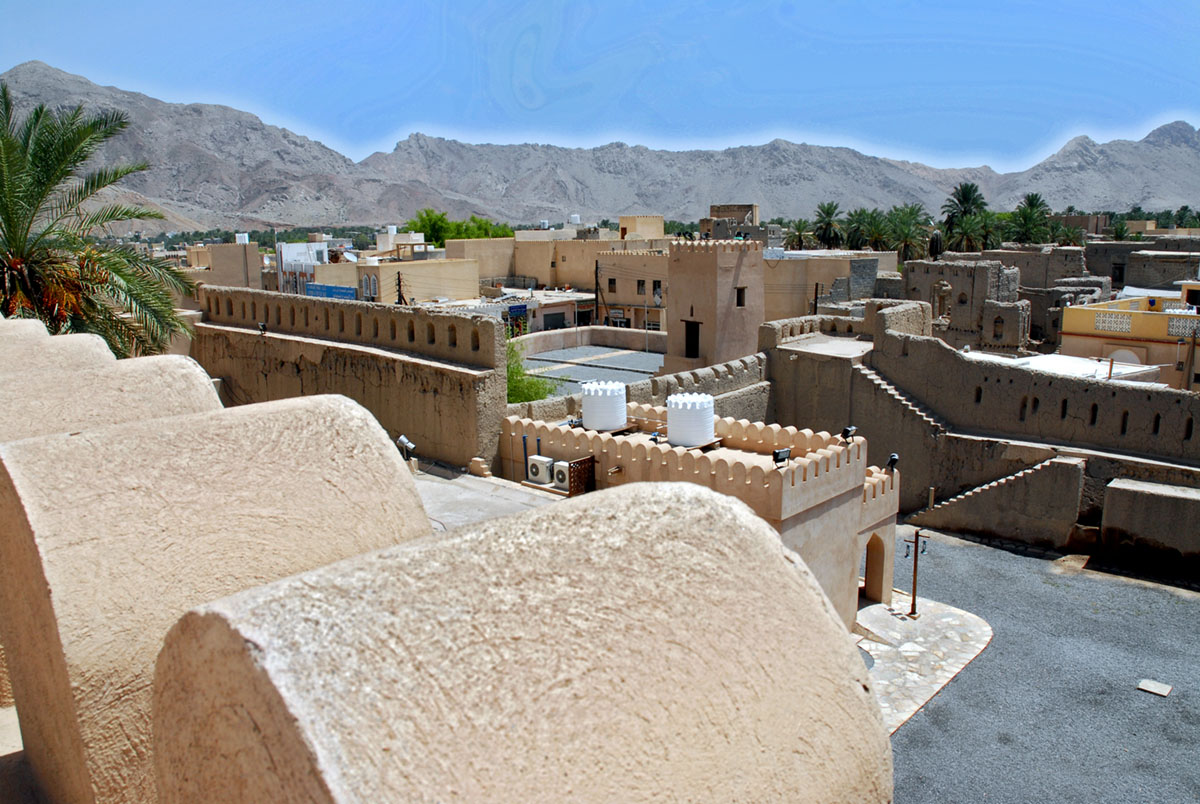
My mother Alice, too, wanted to visit Oman to see Clara there and also meet the Zawawi family into which my sister had once been married. So when Mum came to Malaysia in February of 2006, I suggested we fly to Oman for a few weeks while Hootoksi was away in China with some people from the Malaysian Culture Group to look for Chinese tribal fabrics. Mum was nearly 95 at the time, but still mobile and full of zestful energy.
So here we are, comfortably ensconced at Beit Clara in the Qurm suburb of Muscat. Visits to Zawawi homes and farms for huge and scrumptious lunches and dinners, outings with Clara and Tony's friends, calls at Water World Oman and the Marina and forays up and down the coast and into the mountainous hinterland were the order of the day. And it was a special treat to spend some time with our friends Khalifa and Kate.
Here are images of that wonderful visit...
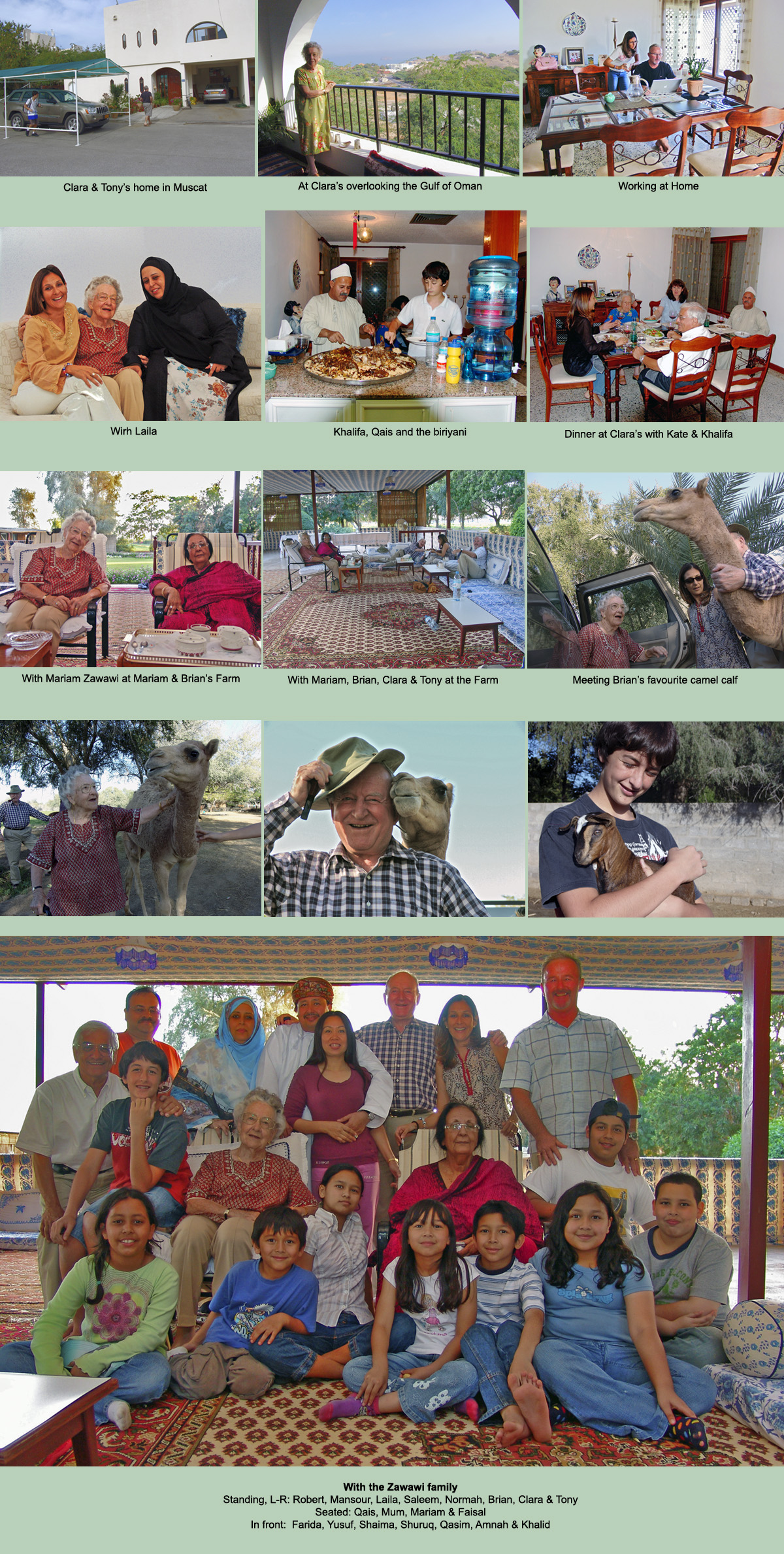
Jebel al Akhdar and Nizwa
The great outdoors in Oman and the siren call of its sands and towering mountains is impossible to ignore for long. So a trip to Oman's highest mountains, the Al Jebel Al Akhdar range, and the old trading town of Nizwa below it, was planned. Mum wanted to come along in spite of the altitude - Hotel Jebel Al Akhdar is at 7000 ft. above sea level - and although her doctor would strongly disapprove if he read this, her Swiss mountain heritage asserted itself and she was soon scampering around on rocky plateaus and posing for photos on the edge of precipices! With its steep slopes, rocky plateaus, deep wadis and quaint mountain villages surrounded by terraced orchards, Jebel Akhdar is a window to Oman's highland communities and a paradise for hikers. The little Hotel Al Jebel Al Akhdar absolutely delighted us with their warm and friendly service and excellent food. I heard that a large tourist resort is on the drawing board and while this could be a good thing for the country's tourism statistics, it will be a crying shame if the natural tranquility and beauty of the area is turned into another playground. Nizwa, one of Oman's oldest trading towns, is famous for its date orchards, fort and souq (market). The fort has been completely renovated and the terraces and ramparts around the original central fortified tower, as well as the main city wall, have been skillfully rebuilt. The fort, the mosque next door and the souq below it together make an impressive attraction.
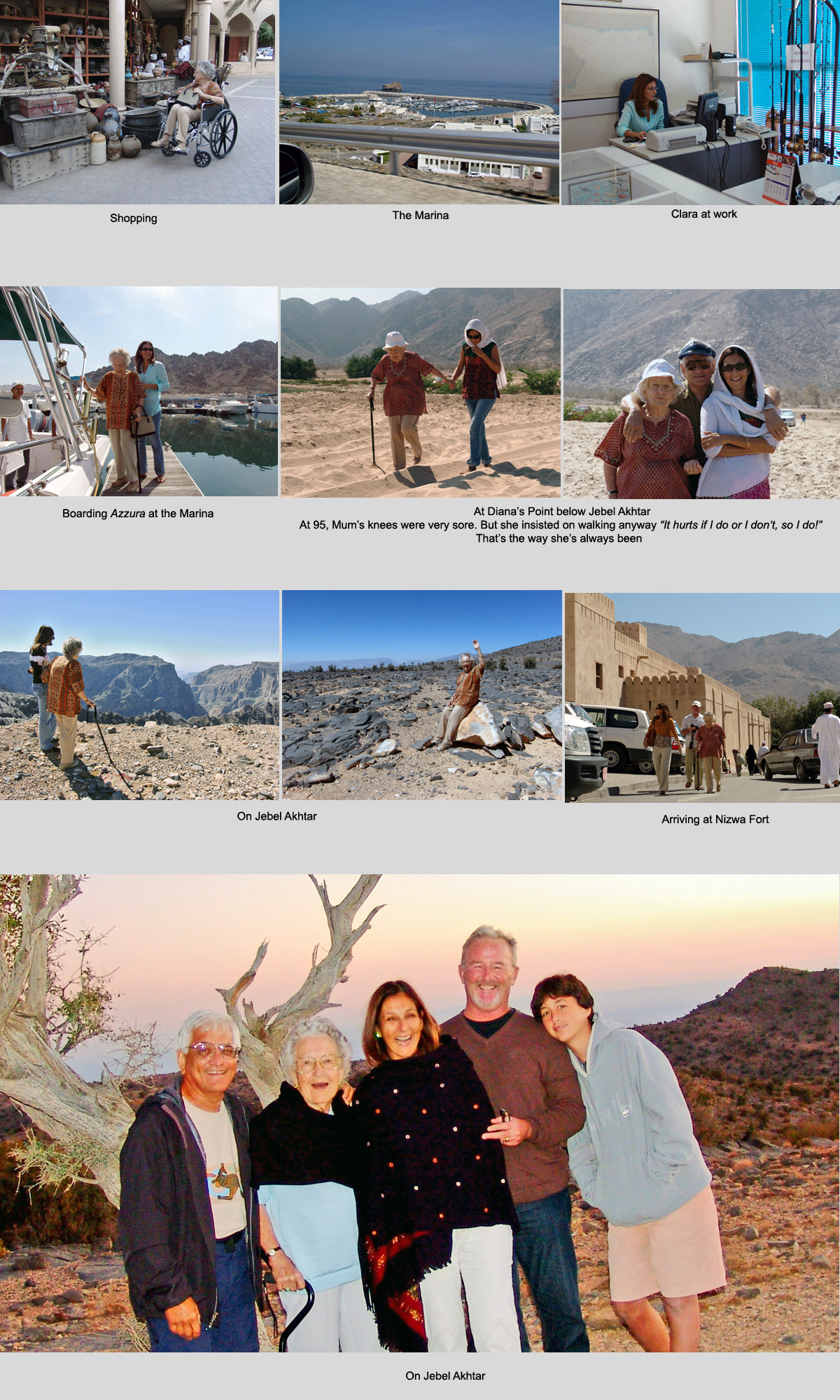
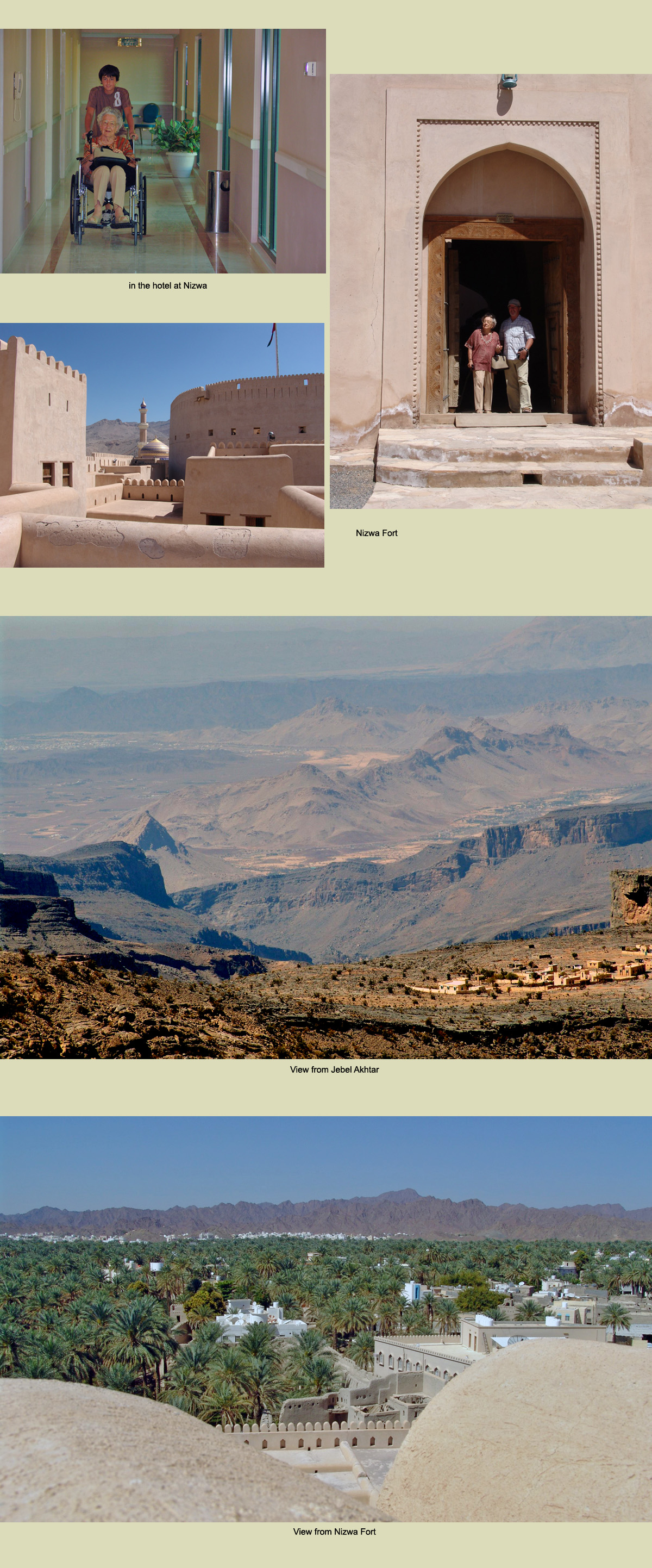
Camping on the Horn of Oman, Al Sharqiya Region
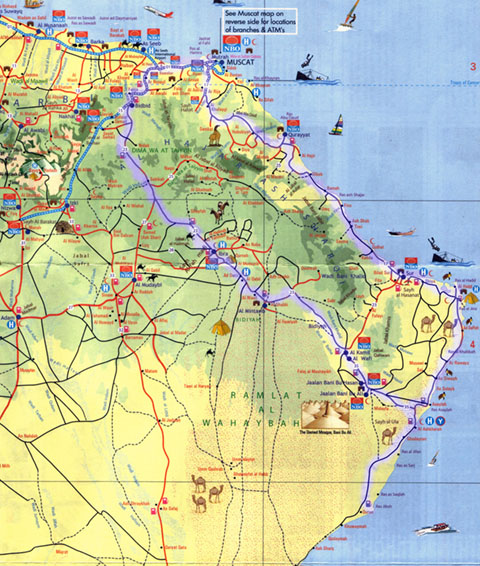 In was our last week in Oman when, on Monday 20 February, Tony packed his luxurious Jeep and he and I set off on a circuitous route through the Hajar mountain range towards the headlands and beaches on the east coast, in the Sharqiyah Region. This region abounds in fertile wadis and steep gorges but also boasts vast sandy plains (the Jalaan and the Wahiba Sands) and a beautiful and unspoiled coastline that stretches for miles to the south west.
In was our last week in Oman when, on Monday 20 February, Tony packed his luxurious Jeep and he and I set off on a circuitous route through the Hajar mountain range towards the headlands and beaches on the east coast, in the Sharqiyah Region. This region abounds in fertile wadis and steep gorges but also boasts vast sandy plains (the Jalaan and the Wahiba Sands) and a beautiful and unspoiled coastline that stretches for miles to the south west.
Tony chose the route carefully (marked in purple on the map) to give me a sampling of the region's varied features. It took us westwards to Bid Bid where we turned south and east in an arc towards the coast at Al Ashkarah. After a late lunch at a local restaurant in town, we drove southwards along sandy tracks through salt flats and to the coast onto a rocky headland at Ras Jibsh, where we made camp. From our perch on the headland the 360-degree views over the flat salt plains and the ocean to the north, east and south were mesmerizing. The sun set in an orange fireball over the desert and after a sundowner we finished a gourmet meal of satay, rice and salad prepared by Clara and cooked to perfection by Tony on the portable charcoal stove. In the moonless sky the stars and the milky way were blinding and as I stared heavenward they seemed to suck me spinning towards them! I hadn't seen the firmament like that since 1987 in Mogadishu when Hootoksi, the boys and I slept on the roof of our house during the 5 months when the city's power station was shut down. Sleeping on fold-out mattresses on a woven reed ground sheet under an awning erected on one side of the Jeep, the night passed comfortably even though the temperature dropped dramatically, and the wind blew steadily till the wee hours.
After breakfast and a mug of brewed coffee, we headed north to Ras Suqlah and made camp above a gorgeous bay with a small rocky headland and a beach stretching southward as far as I could see. Huge turtles poked their heads out of the water at regular intervals while silver thread salmon shot a meter or more out of the simmering water of the bay. In the distance was a cluster of apparently empty houses and a simple, roughly built square mosque. Fishermen were working on their nets near some boats on the sand. I soon learned that these men went to sea at 4 am to set their nets, returned to the beach at 8 am, and then went out again at 4 pm to collect their catch. Occasionally, one of them would spend the entire day out in the bay catching bait fish. Their boats were the standard outboard driven fiber glass model used by coastal communities throughout this part of the Indian Ocean. It was interesting to watch them push the boats into the water with their Toyota pickups. On their return, they would race full tilt at the beach and shoot upwards over the sand, often coming to a rest far beyond the waterline. They would then use the pickups to tow the boats well above the high tide mark. In the morning, one of the men dropped by to give us a fish and that afternoon three others came over for a cup of tea and a chat in broken Urdu. I have yet to meet a friendlier bunch of strangers and by the time we left Ras Suqlah I felt I could return and resume our friendship any time.
The next afternoon we waved goodbye to the fishermen and headed northwards through the sand looking to use the new road that was being built to link the coastal settlements and accelerate development in the region. But soon after we got going on the road, the Jeep's sensors warned Tony that the rear left tire was losing air, so he pulled off the road (a figure of speech, really, as the road was nowhere near completion and there was no shoulder or lay-by) and changed the wheel. By then the tire, which perhaps had been gashed by a sharp stone, was completely flat. This was worrisome as we still had a long way to go to Sur, the only major town where we could hope to have the tire repaired or replaced this side of Muscat.
Sur, the largest town in the region, is an ancient port, trading and ship building center set on picturesque bays and inlets. We had booked at the Ras Al Hadd Beach Hotel but because the hotel was full with tourists we were given 'portacabin' accommodation to one side of the main building, facing the wide beach. That night, after a good buffet dinner, Tony suggested we visit the beach at Ras Al Junayz where giant green nesting turtles famously come ashore under cover of darkness to lay their eggs. The fact that we had no permit to visit the protected beach didn't dampen our enthusiasm one bit and we did a great job of eluding the authorities and walkie-talkie-wielding guides, as we silently weaved between boulders and slipped through the inky darkness to join one of the tourist groups on the beach. Of course, Tony had been here before and was knowledgeable about the turtles' habits, how to avoid stumbling into the huge pits they dig to hide their eggs and how to watch out for the myriad baby turtles that pop out of the sand underfoot, so I hope that our unescorted foray on the beach posed no threat to the wellbeing of Oman's turtle population. For me, watching the huge beasts struggling to cover the eggs and then laboriously trudge back down the beach towards the sea, a meter at a time before resting, stock still, for 3-5 minutes, and finally enter the water in a splash of phosphorescence, was a wondrous and humbling experience. The others must have felt the same way as everyone clapped when a turtle disappeared in a wave. I heard that some females die of heart failure due to the effort and strain! I have watched the miracle of childbirth before - the birth of my own children and, later, in Africa, the birth of a zebra - and it struck me that evolution has dealt these female turtles an unfair hand.
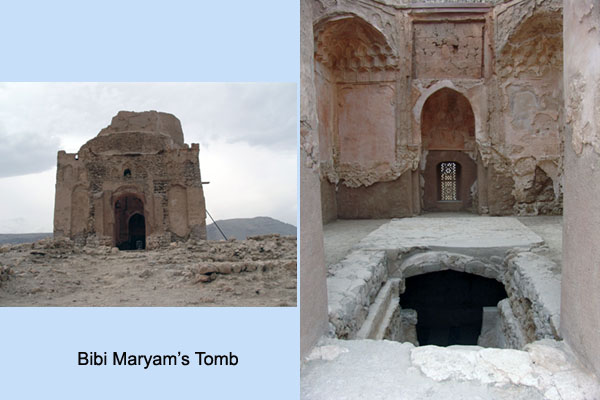 The next day we drove north on a rough road that twists, rises and falls along the cliffs and dunes, hugging the coast. We passed through sleepy, picturesque settlements perched on headlands or nestled among date palm groves in the entrances to wadis bounded on either side by steep cliffs guarded from above by ancient watchtowers and fortifications. At Qalhat, one of Oman's oldest seaports and towns, the ancient city wall, now in ruins, gives one an impression of its past size and glory. In the 13'th century, Qalhat was the main port of trade with the interior and was an important trading post with India for commodities as varied as horses and spices. The tomb of the holy lady, Bibi Maryam, with its underground vault where she was buried, and which was part of a canal bringing water to a falaj (washing place), stands on the clifftop.
The next day we drove north on a rough road that twists, rises and falls along the cliffs and dunes, hugging the coast. We passed through sleepy, picturesque settlements perched on headlands or nestled among date palm groves in the entrances to wadis bounded on either side by steep cliffs guarded from above by ancient watchtowers and fortifications. At Qalhat, one of Oman's oldest seaports and towns, the ancient city wall, now in ruins, gives one an impression of its past size and glory. In the 13'th century, Qalhat was the main port of trade with the interior and was an important trading post with India for commodities as varied as horses and spices. The tomb of the holy lady, Bibi Maryam, with its underground vault where she was buried, and which was part of a canal bringing water to a falaj (washing place), stands on the clifftop.
After a few hours, with the majestic Al Hajar Al Sharqi mountains towering to our left, we began the approach to Muscat. Dark clouds loomed ahead and soon we drove into a wall of rain, which was worrisome as we still had to negotiate a number of wadis and causeways ahead. Evidently we made it through just in time, for soon the big wadis that run along the highway into Muscat, which are bone dry most of the year, had turned into raging torrents, sweeping before it whole trees and even an oil tanker, a bus and some heavy earthmoving equipment. We passed dozens of stranded vehicles and hundreds of very wet people before we reached Beit Clara. It was dusk and we were dry, warm and safe, and ready for the next sundowner. Clara later said "We were terrified for you two because there had been awful flash floods down the wadis near where you were camping; I was sooo happy to finally hear from you on the way home!!!"
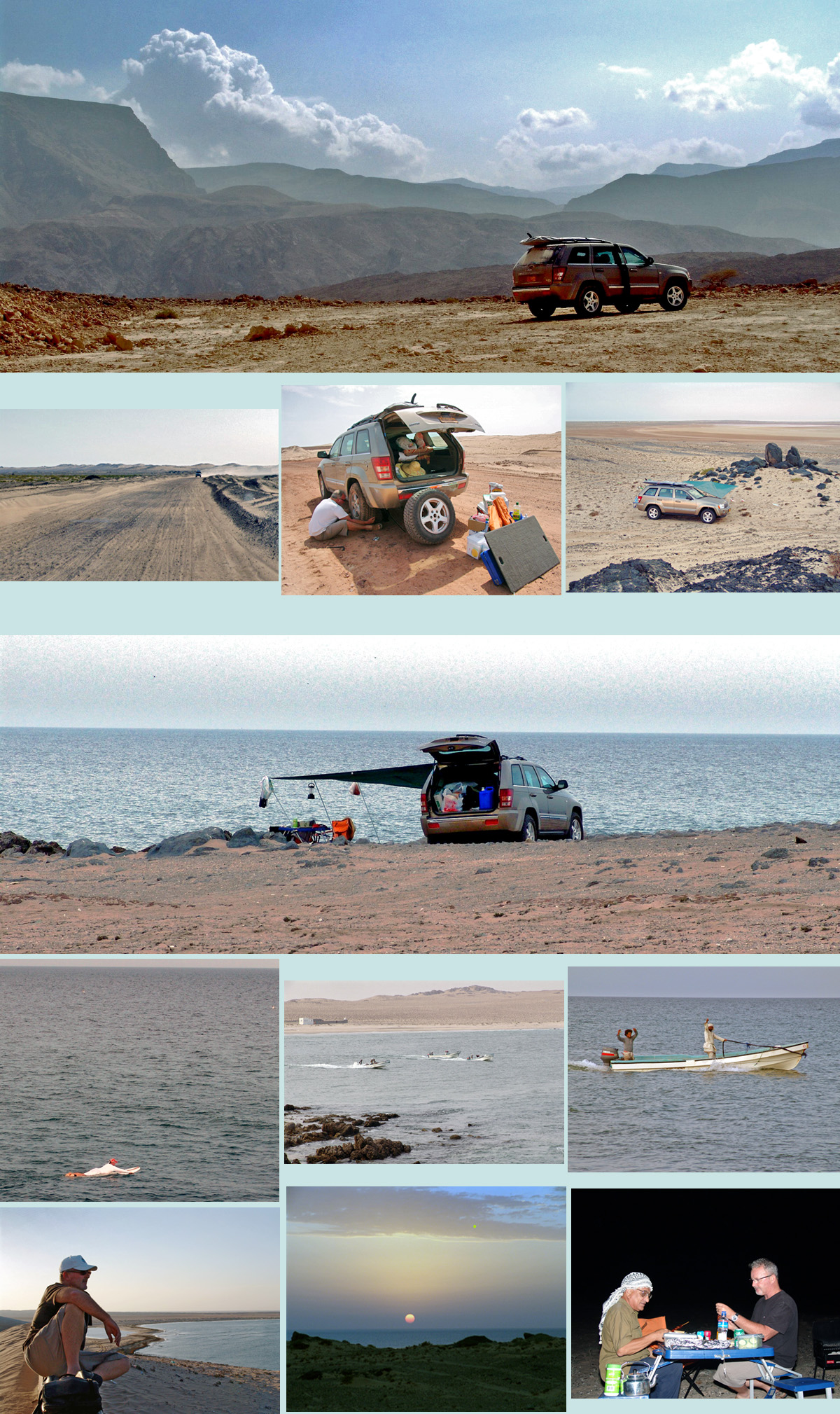
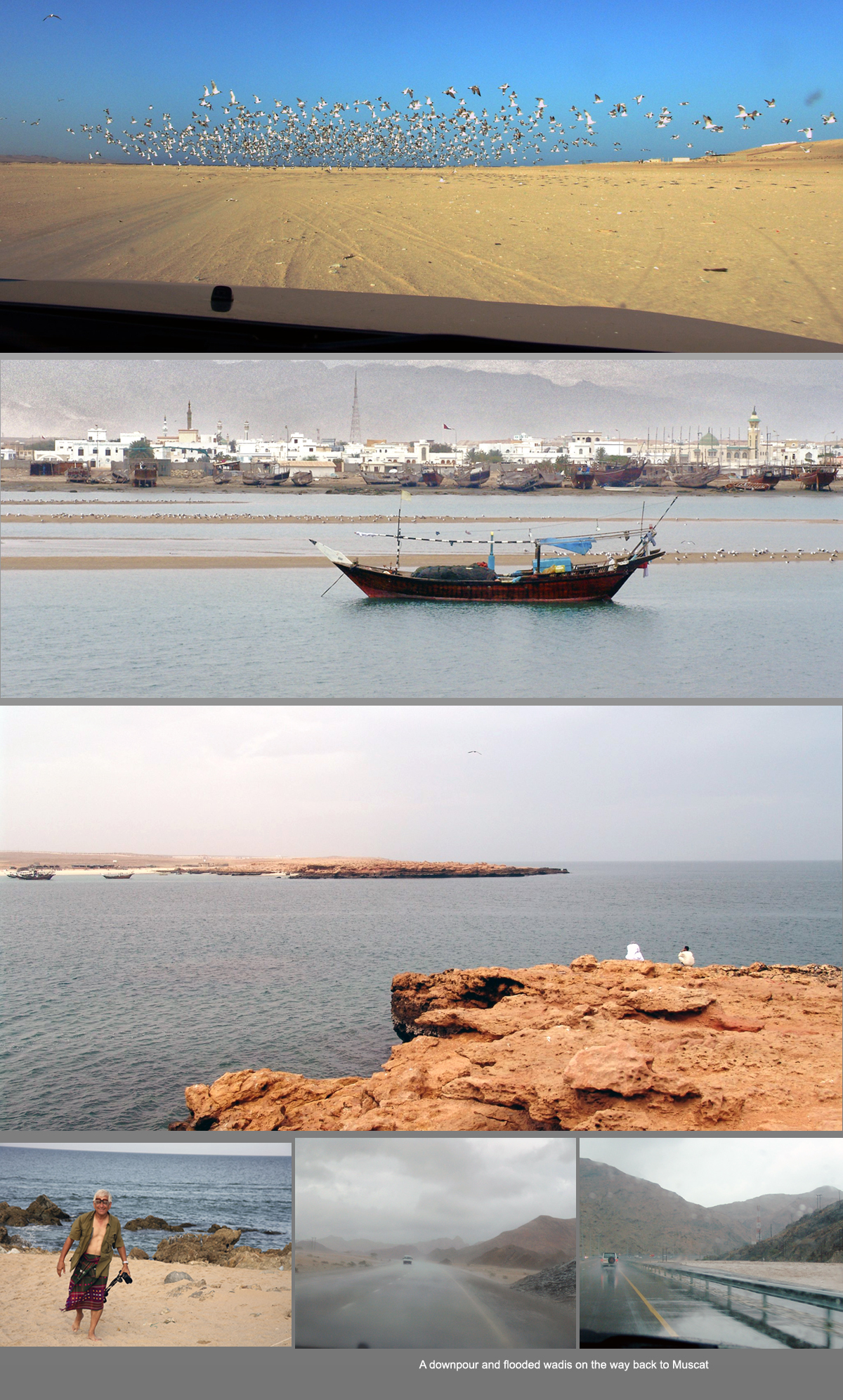
Mum was as happy as I was with that memorable visit. We were thrilled with the progress Clara was making with her high end marine tourism company, and earning an internationally known name for herself. I promised myself another visit; and that wish was to be fulfilled just a few months later!
